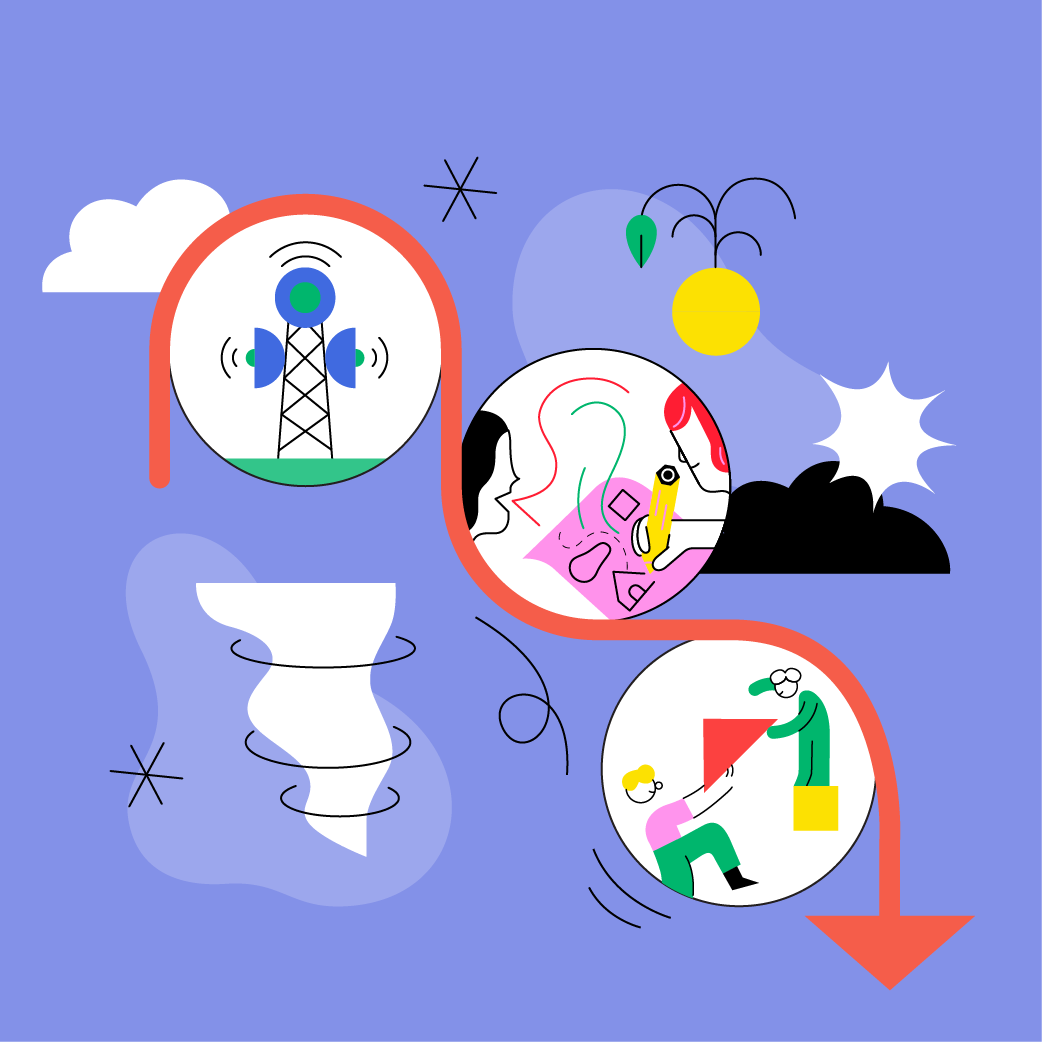
Entertainment for Change
Leveraging popular entertainment for a cause
Introduction
Who does not like to be entertained? A good comic, TV series, book, band, stand-up comedian, reality show, puppet, poet and/or traditional tale, and many other forms of entertainment, are essential to our lives. They can spark a reaction across the full range of our emotions and interests – from joy and laughter to anger and despair, and from personal reflection to discussions with friends and neighbours and collective action. To have that effect, entertainment needs to resonate – to make sense and appeal in a significant and meaningful way –, often engaging and affecting different people in different ways.
Since all of the key development issues are, in essence, people-based at very significant scale – e.g. human rights, conflict, mis/disinformation, gender equity, violence against women, political accountability, education, etc. – it is important for development action to also be people-focused and at scale. Because it attracts and engages, entertainment provides that opportunity.
Often, entertainment programmes also allow people to learn from the mistakes and the success stories of characters with whom they have established an emotional link, rather than having to learn from their own experience. Perhaps it was Meena and Raju promoting the rights of girls through animation in South Asia, or maybe Sara and her pet monkey Zingo inspiring young girls in east and central Africa to stay safe and free of HIV and AIDS. Maybe you’ve grown up loving Big Bird, singing along with Elmo and laughing at Oscar the Grouch. Whatever the memory, chances are good you grew up with and continue to be influenced by entertainment.
There are two major challenges with entertainment for change:
- In the crowded and dynamically changing space that is entertainment – from local to the global – what is the best positioning and where is the prime space for development-focused entertainment initiatives?
- How should organisations focused on humanitarian and development goals do things differently compared to the local storyteller or major film/TV studio?
There is an extensive history and experience within the social and behaviour change community with ‘’edutainment’’ (entertainment-education) initiatives. One collator of action in this field has identified and summarised 4,486 initiatives in English and 876 in Spanish. And that is just the tip of the proverbial iceberg.
Reflecting the essential development principles of South-South collaboration and learning from those experiences, this section of the programme guidance is focused on the collaborative work of two organisations – Heartlines in South Africa and Fundación Imaginario in Colombia. Both have demonstrated the ability to break through with high quality, impactful entertainment initiatives.
Many of the Heartlines leaders were part of Soul City, the hugely popular multimedia edutainment initiative that played a significant role in addressing public health issues (including HIV /AIDS) in South Africa. Heartlines is a South African organisation that develops multimedia initiatives to address social change and encourage people to live out positive values. For example in 2017, Beyond the River – and award winning feature film - addressed social issues relevant to South Africa’s democratic transition from apartheid.
Since 2007, Fundación Imaginario has worked on complex issues of public interest: the promotion of sexual and reproductive rights of adolescents and young people (Revelados, Desde todas las posiciones and Revela2); the promotion of HIV testing for homosexual men (Bondage); young women's entrepreneurship (Women Entrepreneurship); and more recently, the armed conflict in Colombia (Romper el Silencio / Breaking the Silence).
Heartlines was invited to share their expertise and guidelines with the Colombian team during the development and design of Romper el Silencio´s project on truth, transitional justice, non-repetition and historical critical thinking. As a result of this fruitful collaboration, an Edutainment Guide for Social Change was released (and here in Spanish). This section draws from that body of critical reflection (with thanks to Universidad del Norte (Colombia) and The Communication Initiative).
Core Principles
Entertainment works with a wide range of social issues. It can inform, educate, inspire, shift individual behaviours and social norms, and challenge the status quo – including initiating reflection and dialogue on topics rarely talked about. It can reach large audiences (e.g., as a catalyst for social mobilisation, advocacy, and education strategies) but also work well in smaller and local settings. For effective entertainment-based initiatives:
- To be relevant and credible, the entertainment needs to be rooted in the real narratives of cultural and social issues that people are experiencing, and a deep understanding of the way people view their world.
- To transform and change, effective storytelling must be rooted in solid research - a continuous process that investigates the context, the people being engaged, and the barriers to change. It involves continuous pretesting.
- The quality (‘production value’) must be as high and professional as possible, to be able to compete with the best available at the time and, perhaps most important, to maximise the chance to resonate and engage.
- This may be obvious but of course entertainment initiatives need to be entertaining. Yet they can and should work well with other strategies such as social mobilisation, digital engagement, and advocacy for policy change.
Main Theories
Theories help to provide direction when trying to answer core questions. For example, how do people learn? What are the main factors that drive change? How can people with common interests and/or identities best organise and act? The answer to these and other key questions inform strategies for entertainment initiatives.
Fundación Imaginario and Heartlines identified the following theories as being crucial foundations for effective entertainment action. Of course, you could have your own favourites. But not having a theoretical base is not an option for development-related entertainment.

Planning Process
For entertainment purposes, our planning process needs to consider and respond to:
- The relationship between people, communities and the issue being addressed – for example, there is no point doing something on HIV/AIDS (e.g. a local drama), if we do not understand the relevant social norms around sex.
- How entertainment media are consumed, reflected and amplified amongst the key communities we are trying to engage – no point doing something on girls education (e.g., a series of concerts for children and their parents) if there is very little chance of household discussions taking place after those events.
- The clarity and accuracy of the knowledge being shared as understood by the people we are seeking to engage – no point doing something on the importance of gender equity (e.g., a TV drama) if there is a high likelihood that it will be interpreted as reinforcing the role of men as family and community decision-makers.
Heartlines and Fundación Imaginario outlined the following 9-step planning process for effective entertainment-based action:
The STEPS
The following are links to more detailed outlines of each step in this planning process. The nature of what is implemented for each of these steps will depend on the scale and focus of the work you undertake. A local initiative involving, for example, some cultural story tellers may need a lighter touch. Likewise, a traveling drama show that performs in several schools may require less depth. But no matter the focus and scale of your entertainment development action, each of the 9 steps below must be actioned in some way.
Entertainment that seeks to advance development action needs to be research-driven and research-evaluated. In absence of research, then it is just entertainment. If there is any conflict between the creativity process and what the research says – then the research should win the argument.

- Step 3: From Research to Message
- Step 4: The Story is the Message
- Step 5: Designing a Multimedia Strategy
It is tempting to start the conceptualisation and planning of your entertainment with the identification and selection of the media you will use – “Let’s do a TV drama on ...” “Heard a great, new musician last night – let’s ask her to do an album on…” “Have you seen this new street art – let’s do murals about … .” Yet it is important to start the identification of the media to use by considering the following questions.
For most people engaged in entertainment, success is reasonably simple to measure. How many watched or listened? What were the ratings? Did people laugh (or cry)? Were people attentive? Is the audience growing? How do name or brand recognition and revenue evolve? Is there critical acclaim? Is the programme getting sponsors/advertisers? Moving to primetime? Invited to other communities/cities/countries? Being talked about?
But when we specifically undertake an entertainment strategy related to a development challenge (e.g. measles, girls in school, environmental protection) or a social change objective (e.g. children’s rights, participatory governance, gender equity) these need to be complemented with different indicators. Here are examples of how Romper El Silencio and What’s Your Story defined ‘what constitutes real success”:

There is plenty of evidence of impact out there. Research shows that children who watch Sesame Street, for example, improve their school performance. An independent, mid-term evaluation of the Sara project (which included animated videos, comic books and a radio series) provided evidence that girls were positively influenced by Sara to delay sex and avoid situations of sexual abuse and exploitation.
Examples of other evaluations
- Mixed methods approach to evaluate the impact of What’s your Story to improve social cohesion in South Africa
- Tea Cup Diaries: How a Radio Drama is Changing Attitudes in Myanmar
- Pre- and post-broadcast survey explores the impact of Shuga Radio in Tanzania to address HIV
- Online longitudinal cohort study to measure impact of "Cest la Vie!" telenovela on health in West Africa
- Randomised Control Trial to measure the effectiveness of MTV Shuga in Nigeria
- Measuring the impact of Overcome the Fear (Vencer el Miedo), a telenovela in Mexico to address reproductive health, through cross-sectional survey interviews
- Platform Validation and Evaluation Process of Revelados, desde todas las posiciones
- The Simsipur comedy series has increased literacy scores among those who watch by 67%
Additional Resources
- Bridging Theory and Practice in Entertainment Education: An Assessment of the Conceptualization and Design of Tsha Tsha in South Africa
- An Entertainment-Education Initiative on Television: A Glimpse into the Production Process (2014)
- Meena Ki Duniya: The Production Process (2013)
- Entertainment-Education Behind the Scenes: Case Studies for Theory and Practice (2021)
- Edutainment: Using Stories and Media for Social Action and Behaviour Change (2013)
- The Communication Initiative Entertainment-Education Network
- How-to Guides on SBCC from the Health Communication Capacity Collaborative (HC3)
- Strengthening the Evidence to Scale up Entertainment Media in Development
Other Case Studies
- The following are examples initiatives that used storytelling as part of a larger entertainment strategy:
- La Pe’ Ye Ta Kwe Ye Diari uses radio drama to increase tolerance between ethnic and religious communities in Myanmar
- The Bell Bajao campaign encouraged local residents to ring the doorbell to interrupt domestic violence when they heard it. In one year, 160,000 men pledged to take action to end violence against women.
- Sesame Street improved children’s learning around the world
- A serial story about birth spacing encourages uptake of postpartum family planning counselling in Senegal
- An MTV programme combats HIV-related risk behaviours in Nigeria
- A long-running e-e TV show Kyunki was produced by UNICEF India between 2008 and 2011, covering different ‘Facts for Life’ areas
- The Meena Communication Initiative addresses common perceptions and behaviours that inhibit the ability of young girlsto survive and thrive
- Fathers Matter revolves around 6 anthology films. It supports the positive and active role of fathers and father figures in the lives of children
- Revela2 involves a fictional television series complemented by social media, a school outreach programme and other social mobilisation strategies to facilitate dialogue and critical reflection about sexuality and sexual and reproductive health and rights
- Kembali Ke Hutan (Return to the Forest) engages young Indonesians about sustainable development choices through stories on television and social media
- MTV Nishedh uses a television drama and other media to promote positive health and sexual health behaviours among youth
- Toma Mi Mano ("Take My Hand") involves a radio series and social media to address reproductive health and teen pregnancy, rape and gender-based violence, and gang violence
- An interactive game in Rwanda is used to teach conflict resolution skills in youth
- Malawi: An interactive radio show opens communication about sexual health and prevents HIV/AIDS
- Mozambique: A long running e-e radio drama has been sparking change across different programme areas since 2015
- Botswana: A UNICEF Botswana adaptation of MTV Shuga addressed HIV- and SRH-related behaviours
- Peru: The La Sangre Llama (Blood Relations) radio soap opera mobilizes communities to fight anaemia
Reference organizations

Do - Entertainment for Change
Download this article as a PDF
You can download the entire page as a PDF here








